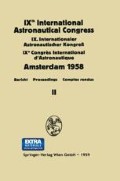Zusammenfassung
Die Umgebung jedes Sternes kann man — nach entsprechenden mathematischen Erwägungen — in fünf verschiedene Sphären des Raumes einteilen, in dem Planeten von verschiedenem ökosphärischem Typus vorhanden sein können. Es sind dies die folgenden:
-
1.
Die Sphäre der gehemmten Planeten mit „ökosphärischem Gürtel“ auf der „Tagesoberfläche“.
-
2.
Die Sphäre der „polaren“, rasch rotierenden Planeten, die im allgemeinen durch den Fixstern „überhitzt“ sind, aber in den polaren Gegenden ökologische Bedingungen besitzen können.
-
3.
Die eigentliche Ökosphäre der rasch rotierenden, belebten Planeten.
-
4.
Die Sphäre der “äquatorialen“, rasch rotierenden Planeten, die nur in den tropischen Gegenden ökologische Bedingungen haben können.
-
5.
Die Sphäre der leblosen Planeten, die wegen ihrer niedrigen Oberflächen-temperatur keine Bedingungen für organisches Leben bieten.
Abstract
The surroundings of every star can be divided—after appropriate mathematical considerations—into five different spheres of space where planets of different ecospheric types can exist, namely:
-
1.
The sphere of the inhibited planets with an “ecospheric belt” upon the “daylight surface”.
-
2.
The sphere of the “polar” planets with swift rotation which generally are “overheated” by their sun, but can show ecological conditions in their polar regions.
-
3.
The very ecosphere of the fast-rotating animated planets.
-
4.
The sphere of the “equatorial” fast-rotating planets which can have ecological conditions only in their tropical regions.
-
5.
The sphere of the unanimated planets which do not offer any conditions for organic life because of their low surface-temperature.
Résumé
Par des considérations mathématiques le voisinage de chaque étoile peut être divisé en cinq sphères, dans lesquelles des planètes de type écosphérique différent peuvent se présenter:
-
1.
La sphère des planètes freinées pourvues d’une “ceinture écosphérique” sur leur face éclairée;
-
2.
la sphère des planètes “polaires” en rotation rapide, en général surchauffées par l’étoile fixe mais susceptible de présenter des conditions écologiques dans les régions polaires;
-
3.
l’écosphère proprement dite des planètes habitées en rotation rapide;
-
4.
la sphère des planètes “équatoriales” en rotation rapide, qui ne présentent des conditions écologiques que dans leurs régions tropicales;
-
5.
la sphère des planètes sans vie du fait que leur température de surface est trop faible.
Access this chapter
Tax calculation will be finalised at checkout
Purchases are for personal use only
Preview
Unable to display preview. Download preview PDF.
Literaturverzeichnis
J. Gadomski, in: Proceedings of the VIIIth Internationa] Astronautical Congress at Barcelona, 1957, S. 127. Wien: Springer, 1958.
P. Baize, Compagnons “planétaires” des étoiles. Bull. Soc. Astronom. France, 1949, 148.
Author information
Authors and Affiliations
Editor information
Rights and permissions
Copyright information
© 1959 Springer-Verlag Wien
About this chapter
Cite this chapter
Gadomski, J. (1959). Fünf Arten von ökosphärischen Planeten. In: Hecht, F. (eds) IXth International Astronautical Congress/IX. Internationaler Astronautischer Kongress/IXe Congrès International D’astronautique. Springer, Vienna. https://doi.org/10.1007/978-3-7091-4745-0_20
Download citation
DOI: https://doi.org/10.1007/978-3-7091-4745-0_20
Publisher Name: Springer, Vienna
Print ISBN: 978-3-7091-4595-1
Online ISBN: 978-3-7091-4745-0
eBook Packages: Springer Book Archive

